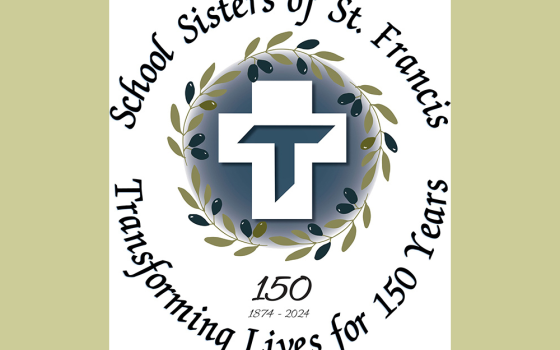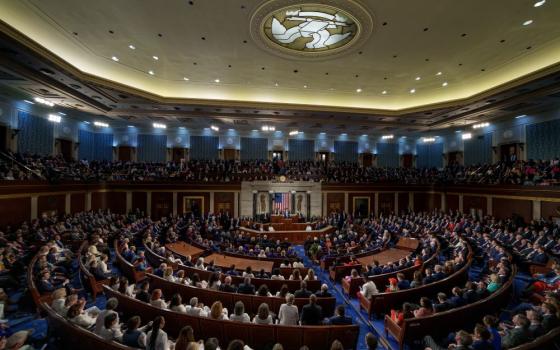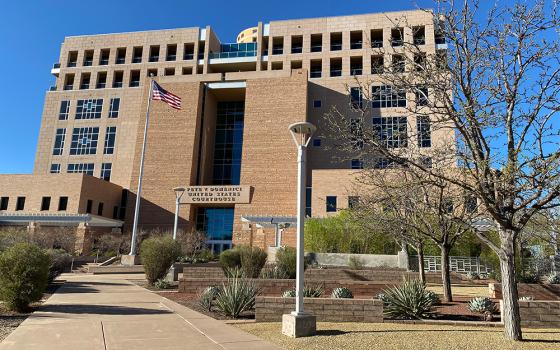This is part one of a series.
Although the term "new monasticism" has been floating around ether of the contemplative world for several decades, it has remained difficult to define.
Catholic incarnations of the new monasticism movement have sprung up since the 1970s in Europe and the United States. Some have come in the form of third-order or lay associates programs in religious communities.
More recently, the term has been adopted by evangelical young adults who embrace a radical commitment to social justice, often living in communities based in some of the poorest neighborhoods in the country. A visit to newmonasticism.org takes one to the virtual base camp of this version of movement, including their fundamental values, their "School of Conversion" and an introduction to their communities across the nations.
It also offers a link to the evangelical new monasticism's highly popular books, including their recent Common Prayer: A liturgy for ordinary radicals. The text is remarkable in that it was produced by young men who grew up in a Christian denomination that is not only allergic to liturgy; it is adverse to any prayer that isn't spontaneous (with the exception of the Lord's Prayer, of course). Tradition seems to be speaking to even the most nontraditional of Christians.
This form of the new monasticism is by far the most visible, thanks in part to the support and promotion they receive from rock star progressive evangelicals like Jim Wallis and Tony Campolo. But true to its evangelical roots, this new monasticism is also rigorously Christian, less oriented toward the mystical qualities of traditional monasticism and, it appears, not inclined to engage with the spirituality of non-Christian contemplatives.
An emerging interpretation of new monasticism, however, promises to broaden the movement in ways that might welcome larger numbers of young adults who find themselves drawn to the spiritual practices of multiple faith traditions. In the recently published "New Monasticism: An Interspiritual Manifesto for Contemplative Life in the 21st Century," Adam Bucko and Rory McEntee explore their vision of what the "new monk" might look like, what it means to be a monk in the world, and the crucial role elders play in mentoring younger contemplatives.
In the manifesto, Bucko and McEntee, both 30-somethings who were raised Catholic, bring their connections to interfaith spirituality to the milieu of new monasticism. Both have been inspired deeply by Catholic mystics whose spiritual lives drew from the contemplative wisdom of the East and the West, like Thomas Merton, Fr. Bede Griffiths and Fr. Henri Le Saux (also known as Abhishiktananda).
Rather than calling their vision "interfaith," though, they use the word "interspiritual," a term coined by McEntee's mentor, Br. Wayne Teasdale.
"Brother Wayne believed that the world's wisdom traditions were moving beyond the stage of dialoguing about one another's beliefs and rituals," McEntee told me in a phone interview from his home in Los Angeles. "Interspiritual means that once that deep respect and trust has been established among different spiritualities, we can actually move to the next level of sharing our mystical realizations with one another on an experimental level."
McEntee first met Teasdale through a tutorial on Thomas Merton that he was taking as an undergraduate at Lake Forest College in Illinois. He and Teasdale crossed paths again at the 1999 Parliament of the World's Religions.
"Every evening of the conference, Brother Wayne would invite a group to join him for conversation and White Russian cocktails," McEntee laughs. "We would be there for hours. It was the start of my first spiritual mentorship."
Teasdale, who died in 2004, invited McEntee to stay at the monastery in Chicago where he lived.
"I worked with Brother Wayne on the next Parliament. From that point, my whole focus has been the spiritual path," he said.
In addition to being a mathematics teacher in Los Angeles, Rory is also currently the administrator for the Snowmass InterSpiritual Dialgoue, formerly known as The Snowmass Conference, founded in 1984 by Fr. Thomas Keating.
In addition to the mystics of the 20th century, McEntee and Bucko are equally inspired by contemplatives in action like Dorothy Day, Mother Teresa and Catherine Doherty. Bucko's first exposure to the prophetic work of justice came as a child in Bialystok, Poland.
"I still have memories of activist priests being killed by the totalitarian regime," Bucko said. "They understood that saying yes to God requires saying no to injustice."
Bucko immigrated to the U.S. in his late teens and studied theology and philosophy at St. John's University in Jamaica, Queens. (Full disclosure: Bucko and I were actually friends and fellow religious studies majors at St. John's in the late 1990s.) After graduation, he moved to India to live in Sewa Ashram, an "experimental community of the poor," Bucko says, "where prayer and activism met beautifully in sacred service offered to victims of AIDS, abuse and social estrangement."
Although the level of illness and poverty he witnessed was unthinkable to most American imaginations, he was transformed by the high-risk outreach work that he performed alongside the ashram's founder, Ton "Ton Baba" Snellaert, and its members, many of whom were Hindu. But perhaps the greatest impact on his consciousness came one day when members of an American Evangelical Church, who had largely funded the ashram, attempted to shut down the center because the staff was not trying to convert its guests into "confessing Christ as their personal Lord and Savior."
"People were practically being resurrected back to life by the care they were given by people at the ashram, and yet it wasn't good enough for this church," Bucko said. When he eventually left India, Bucko brought the wisdom and passion that he learned to the U.S., where, for years, he worked in the streets trying to rescue homeless and runaway youth.
In 2004, Bucko and his friend Taz Tagore cofounded the Reciprocity Foundation, an award-winning nonprofit that empowers New York City's homeless and at-risk youth to break the cycle of poverty. Many of Reciprocity's students have run away from home, so Bucko often finds them by wandering Manhattan's Port Authority bus terminal in the wee hours of the morning.
"As soon as they step off the bus, there is a chain of pimps waiting for them, ready to promise them 'the future that they dream of,' " he said. "Our job is to catch the kids before they become victims of this never-ending cycle of horror, abuse and prostitution."
In addition to helping them find shelter, teaching them life skills and trying to connect them with internships and employers, the staff of Reciprocity also guides them in being in touch with their spirits. There is a teacher who leads them in yoga classes, and some eventually go on retreats at a Buddhist monastery in upstate New York.
"But we don't start with Buddhism or yoga," Bucko said. Instead, they employ a "whole person" approach to each student.
"We ask them bring all aspects of themselves into the room," he said. "Their fears, their hurts, their beauty. We sit with it together and hold it and are present to it. And if we sit long enough, something will emerge. It really is a contemplative process, but it is a more experiential approach to spiritual direction and spiritual friendship."
Bucko and McEntee's paths crossed in 2010 at a meeting of another emerging group known as the Young Contemplative Alliance.
"Adam was a leader in the group, and I learned about it at the last minute," McEntee said. "We even didn't get to talk until everyone was leaving the meeting. We realized how similar our journeys had been and how we both sensed the same movements of the spirit in the new generation of contemplatives. It was the start of this two year dialogue we've been having."
A shared retreat at the Sky Farm Hermitage in the hills of Sonoma, Calif., planted the seeds that would grow into the manifesto.
"While we were there, Sr. Michaela Terrio, one of Sky Farm's hermits in residence, gave us an article she had recently read about being monks in the world," McEntee said. Terrio began her religious life as a Cloistered Poor Clare Nun for 17 years and, after a trip to India, became a student of Fr. Bede Griffiths.
The article, which drew heavily on Fr. Ramon Pannikar's book Blessed Simplicity, gave McEntee and Bucko a framework for imaging how young adults can embody an interspiritual new monasticism in a postmodern world.
"If you look at the demographics, the number of young people who identify as 'spiritual but not religious' is quite high," McEntee said.
Both he and Bucko were concerned that some young people only know the spirituality offered by New Age thought.
"Adam and I share the belief that the real contemplative depth is in the traditions. Depth and wisdom are often lost in the translation to New Age spirituality, which can be shallow in certain areas," McEntee said.
"The manifesto is a response to something we've been feeling in our hearts for a long time," Bucko said. And apparently it is resonating with the hearts of both old and young contemplatives alike. The manifesto has "gone viral" since the pair began emailing it to friends and colleagues during the summer.
"We would send it one friend, only to find out she had already received it from two other sources," Bucko said.
Much as Bucko and McEntee want to live and serve in the world, they are aware that growing secularism, individuality and the decline of interest in institutional religion and religious communities threaten to overshadow, if not extinguish altogether, the richness that Eastern and Western spiritual traditions can continue to offer humanity.
"Our generation has a great responsibility," Bucko said. "If we don't figure out how to take the best of our traditions and pass them on, they may not be there in the future."
Part two of this series, which will offer an in-depth look at the manifesto, will appear next Monday.
Read more in this series
- Two young adults offer a new take on 'new monasticism'
- New monasticism: Envisioning monks without borders
[Jamie L. Manson received her Master of Divinity degree from Yale Divinity School, where she studied Catholic theology and sexual ethics. Her columns for NCR earned her a first prize Catholic Press Association award for Best Column/Regular Commentary in 2010.]
| Editor's note: We can send you an email alert every time Jamie Manson's column, "Grace on the Margins," is posted to NCRonline.org. Go to this page and follow directions: Email alert sign-up. If you already receive email alerts from us, click on the "update my profile" button to add "Grace on the Margins" to your list. |




